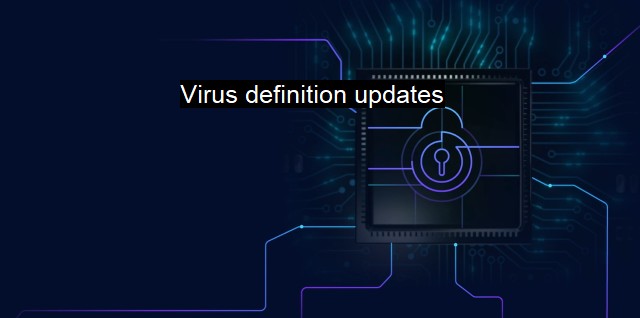What are Virus definition updates?
Fortifying Cybersecurity: The Powerful Role of Virus Definition Updates in Antivirus Software
The term "virus definition updates" bears immense importance. these are regular updates released by antivirus software companies to ensure that their product remains effective against the latest cybersecurity threats.Antivirus software works by scanning computer systems for patterns of data, known as virus signatures or definitions, that match known threats. Each virus definition represents a unique sequence of code in a particular strain of malware. Antivirus packs safeguard the computer systems by isolating or eliminating any files or programs that contain these suspicious signatures.
The database of virus definitions a software maintains is the antivirus's blueprint for hunting malicious elements. It's akin to placing a bounty on the most-wanted cyber threats, allowing the software to actively recognize and defend against these invaders. These virus signatures are used by the software to detect whether a file, program, or a system, has been infected or compromised.
Given the constant advancements in technology, hackers and cybercriminals are persistently creating new viruses, or modifying the existing ones. Each new virus or malware represents a novel challenge for the antivirus software; a fresh blueprint that it has yet to see. Therefore, these emerging threats can often slip past an antivirus's antivirus vigilance and wreak havoc on computer systems.
This is where virus definition updates become crucial. Software companies continually track and study these emerging cyber threats, updating their virus definitions accordingly. By regularly releasing virus definition updates or inherit an updated malicious blueprint, these companies help ensure that their software can capably deflect the latest versions of viruses or malware.
With each virus definition update, the new data is incorporated into the antivirus's existing threat database. After installing these crucial updates, the antivirus software becomes familiar with the new cyber threats, equipped to detect and incapacitate them effectively when they attempt to infiltrate the protected system.
Often, these virus definitions updates might be programmed to download and install automatically. Routine updates, which might take place daily or even several times a day, help keep the antivirus shield resilient to the ever-evolving cyber threats. a user might also choose to manually download and install these updates. This practice, although less common, is generally followed when a person either wants to maintain a notable degree of control over their system updates or stave off potential software incompatibility issues.
The cybersecurity landscape is akin to an ongoing battlefield where the offenses and defenses are ceaselessly undergoing modifications. In this dynamic scenario, virus definition updates become the arsenal that fortifies the antivirus shield against the unrelenting surge of new and improved threats. Without these recurrent updates, the antivirus software would progressively lose its efficacy, making it highly susceptible to cyber-attacks.
With digital transformation becoming increasingly pervasive, the relevance and urgency of virus definition updates have risen manifolds. As businesses and individuals rely more and more on digital mediums for their everyday operations, they expose themselves to a broader spectrum of cyber threats. With the Internet forming the backbone of this digital milieu, this issue is further accentuated due to internet-born threats such as ransomware, spyware and phishing attacks,
Thus, virus definition updates not only lend vigor to the antivirus systems but also serve as the bulwark against the expanding and mutating range of cyber threats. It is through a relentless cycle of studying the newest threats, creating updated virus signatures, and distributing these to their user base that antivirus software continues to safeguard the digital universe efficiently.
To sum it up, in the contemporary world marked by high digital dependence, these definition updates bear added significance. These continually updated lines of defense help us safely navigate the vast digital seas that are home to an array of unceasingly evolving cybersecurity threats.

Virus definition updates FAQs
What are virus definition updates?
Virus definition updates are updates that provide the antivirus software with the latest information about new viruses and malware. These updates ensure that the antivirus can detect and remove the latest threats from your computer.How do virus definition updates protect my computer?
Virus definition updates protect your computer by ensuring that your antivirus software is up-to-date with the latest information about new viruses and malware. This enables the antivirus software to detect and remove the latest threats from your computer, keeping it safe from harm.How often should I update my virus definitions?
It is recommended that you update your virus definitions at least once a week, but ideally, you should set your antivirus software to automatically check for updates on a daily basis. This will ensure that your computer is always protected against the latest threats.What happens if I don't update my virus definitions?
If you don't update your virus definitions, your antivirus software won't be able to detect or remove the latest viruses and malware. This puts your computer at risk of infection, and it may not be able to function properly. Additionally, if your computer becomes infected, it may spread the virus to other computers on your network, potentially causing widespread damage.| | A | | | B | | | C | | | D | | | E | | | F | | | G | | | H | | | I | | | J | | | K | | | L | | | M | |
| | N | | | O | | | P | | | Q | | | R | | | S | | | T | | | U | | | V | | | W | | | X | | | Y | | | Z | |
| | 1 | | | 2 | | | 3 | | | 4 | | | 7 | | | 8 | | |||||||